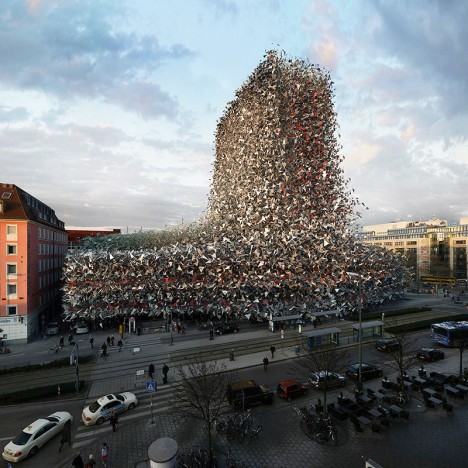John Tischer '71: As If It Was Happening (for Brautigan)
Alicia Hutchison Steffann '94: Guest Napper #192: Diaper Stand
Kevin Draper '10: Smoothing Over the Rough Edges: Mandela, the NBA and Manicuring Memory.

On Monday, former South African president Nelson Mandela was laid to rest after a week-long goodbye, and thus concluded an event that the world has not seen perhaps in its history. Few human beings have possessed a life history and resume that could inspire an event like the funeral of Mandela — a weeklong celebration replete with controversial diplomatic selfies, symbolically powerful handshakes between long-time enemies, and Lacobian boo-fests for unpopular current South African presidents— and in that regard, we may not see another moment like this again. Indeed, the Mandela finally interned in his family plot in Qunu after 95 years on earth was as much myth as memory; a complicated but almost universally celebrated legacy of resistance, militance, imprisonment and nation-building in South Africa. And, unsurprisingly, given the almost agreed-upon stature of the deceased, there has been a large focus to link people, polities and institutions to Madiba, in an effort to gain a number of benefits from his still-radiant aura. Of course, a set narrative that can be easily repackaged and redistributed, and applied to multiple situations seems to be the main boon of this process. Uncynically, this narrative can be used to help make memories permanent and lasting. But of course, the additional purpose of this focused narrative-generation is to profit; to turn the memory of the man into money.
Due to circumstance — whether it was tragic or not really is in the eye of the beholder — the NBA was one of the first to begin to incorporate the name and memory of Mandela into their larger product line. The NBA’s weekly national double-header was on TNT the night of Mandela’s death, and being that it was the only major sport on immediately after news of Mandela’s death broke (save for Thursday Night Football), the wildly irreverent Inside the NBA crew was tasked with handling the first round of “largely disconnected professional athlete eulogizes transcendent global figure on the behest of the league.” And, to their credit, the crew did quite well with a difficult task. In their collective remembrances, a few common themes emerged. Hill, O’Neal, Barkley and Smith all focused on Mandela’s “compassion” towards his jailers after spending 27 years in captivity (including huge stretches in solitary confinement), as well as the “sacrifices” he made for the creation of the modern South African state. As larger-than-life men themselves, they easily lined up Mandela alongside men like Martin Luther King, Jr. and Muhammad Ali; global figures worthy of an eternity of admiration and praise. Shortly thereafter, David Stern offered condolences from the NBA, and made mention of his importance in the world of sport. “Nelson Mandela was one of the most powerful and inspirational leaders in the world and a great friend of the NBA,” he wrote in an official statement, adding that “he led his nation to democracy at incredible personal sacrifice, and in rebuilding it, he understood how to harness the power of sport to inspire and unite people of all backgrounds.” But that very same night, with the eulogies out of the way, and almost as an afterthought, hip-hop-heavy commercials for Long Walk to Freedom, the forthcoming film adaptation of Mandela’s autobiography starting Idris Elba, started appearing in commercial breaks between in-game action, and have been on during every national television game ever since.

In many ways, it’s not strange that the NBA would attempt to create a connection between itself and Nelson Mandela, given that there is something of a relationship between Mandela and the NBA, and more generally, the political deployment of sport in order to create diplomatic and financial bonds. Indeed, as David Stern points out (and, more recently, as portrayed in the movie Invictus), Mandela did use rugby as a way to foster civic unity in the restive early days of the post-Apartheid South Africa, so it is reasonable to associate him with sport, and statesmanship in general. And additionally, Mandela did maintain a relationship with the NBA that could be described as friendly, if not terribly meaningful. Sekou Smith detailed the NBA’s first foray into South Africa in 1993, where Mandela served as an early ally in the establishment of the Basketball Without Borders program, which has served as the NBA’s most purposeful (and profitable) forays into the global south. Additionally, Bejamin Hochman of The Denver Post recounted the role Mandela played for Dikembe Mutombo, the long-time NBA center who had the good fortune of meeting Mandela twice; once in 1993 with the official NBA-sent delegation, and again over 10 years later, when Mandela was in the hospital, slowly declining. Like everyone else, Mutombo’s focus was on the imprisonment and subsequent rise to power, and his attempt to unify a deeply fractured population through the Truth and Reconciliation Commission. ”This man spent 27 years in jail, was about to run for presidency of the new South Africa and he decided to meet with us,” Hochman quotes Mutombo as saying. “He believed that sport was the way to bring white and black South Africans together. Mandela unified the nation through the sports — sports can change the community, sports can change the world. It can change a human being with how they think, how they look at each other.” Like his peers, Mutombo’s analysis of Mandela starts in prison, and ends in Johannesburg, laid in state, and fondly remembered as a statesman and a gentleman.
However, we cannot ignore the fact that the NBA seems to be equally concerned about portraying a version of Mandela that is acceptable to the largest, most moderate audience; a watered-down version of a deeply complicated modern historical figure. In both the secondary media exhumed for the purpose of linking an institution to a individual of great magnitude, and the primary media created specially for the occasion of his passing, we see with troubling certainty that the NBA is purposefully working to develop a particular version of Mandela that can be easily consumed and regurgitated among a vast purchasing group. There has been no mention of Mandela’s militant past as a fighter for the African National Congress, the ruling party of the South African government who only came out from underground at the end of the twentieth century, were listed on almost every terrorist watch group in the world. There has been no mention yet of Mandela’s longstanding relationships with men like Yasser Arafat and Fidel Castro; men who are generally regarded as enemies to West, but whom Mandela considered to be friends and allies; former third-world liberators who stood by the South African president when the vast majority of the world would not (divestment was not yet a popular trend on college campuses). Instead, what we have gotten is a cookie-cutter image of Nelson Mandela; one that is part Gandhi, part Dr. King, and part Barack Obama If we disagree, Joakim Noah and Brook Lopez both recommend that we go see Long Walk to Freedom. “I feel this film is really important,” says Brook Lopez, Nets center and noted Mandela scholar, “it tells the whole story.”

In the memory of Mandela — as well as the other leaders the NBA chooses to glorify — we are not just struck by who they talk about, but also who they choose to ignore; who they smooth over to make the edges less rough. Had he not been killed by the South African state in 1977, one wonders how NBA players — and the NBA — would remember Steve Biko, the developer of Black Consciousness, a more militant form of black liberation which rose after Mandela and the ANC was banned, killed and imprisioned. How would the NBA have dealt with his memory; one that roots itself in liberation of specifically blacks, and not a rosy, rainbow-tized vision of racial harmony and peace after a century of violent repression? Additionally, one also wonders why the NBA hasn’t maintained a focus on still-living freedom fighters, such as Mamphela Ramphele of South Africa, whose efforts are championed to this day, all over the world. Why does the NBA only ask its players and coaches to remember a person when they are dead, and when they can profit from attention? Why does it seem that the NBA only chooses to remember the great ones when they are gone, and cannot speak up for themselves?

About a year ago, as the NBA participated in its annual rite of evoking the name and a very particular memory of Dr. Martin Luther King, Jr., to sell a daytime slate of games, I wrote that making memory was tricky; and not always a noble task if it involved making a profit. At the time, I argued that if the NBA wanted to invoke the memory of Dr. Martin Luther King Jr. to push their product, they needed to be historically accurate in their portrayal of him, and properly contextualize both the person he was becoming when he arrived in Memphis in 1968, and the places that he was going before a bullet ended his life on a hotel. And while much of this sentiment remains for the memory of Mandela, it almost seems doubly pertinent, given that the NBA actually has a history with the man. Indeed, there are pictures of Mandela holding NBA jerseys; smiling with David Stern and other members of the NBA’s monolithic brass. But his importance goes much deeper than that; far beyond an iconic prison on Robben Island and a life as a formal statesman. His is a history of Pan-African liberation; of a revolutionary moment that, at this point, has been corporatized, put onto t-shirts, coffee mugs, and big movie screens all over the world.
Undoubtedly, a great man was laid to rest this week. My only hope is that the NBA chooses to honor his legacy fully and completely, and not just in the way that will make them the most money.

Kurt Kohlstedt '02: Reconstructionism: 88 Dramatic Deformations of 1 Building

His world-famous photo manipulations span the globe but this time with a twist: a single seemingly-unremarkable structure bent, broken, shattered, turned, twisted and reformed in dozens of ways.



Victor Enrich starts with an intentionally plain subject – an ordinary hotel in Munich, Germany – then begins to unravel it floor by floor, split it up the middle, peal it like an onion, inflate it like a balloon, flip it from side to side and much more. Essentially any adjective you can think of has been visually applied to deform this building.



Like an architect with an over-active imagination or impossibly-demanding client, he envisions seemingly endless configurations while variously (depending on the piece) respecting the overall material, language, volume and (/or) site of the subject structure. Each piece is in some way recognizable with reference to the original, even when it pushes the boundaries of physical possibility.



The resulting works can be viewed on his site and are summarized in the video shown here. Each is also available as a reasonably-priced print if from his website any grab your eye in particular, or grid editions (multiples on a single print) if you wish to frame your own sequence of deconstructions.





[ By WebUrbanist in Art& Photography & Video. ]
[ WebUrbanist | Archives | Galleries | Privacy | TOS ]

Kurt Kohlstedt '02: Guerrilla Gardening: Shotgun Shells Filled with Flower Seeds

Seed bombs have long been a (non-violent) weapon of choice for guerrilla gardeners, but Flower Shells now aim to make your 12-gauge shotgun a key part of your go-green arsenal. Perhaps these will redefine ‘flower power’ for a new generation of eco-warriors, though a bad misfire might instead give new meaning to ‘pushing up daisies’.

“A personal project between art, gardening and gun smoke,” these are what they sound like: modified shotgun shells filled with seeds, all designed to make gardening more fun.

Their inventor, after“hour and hours of weeding, seeding and cutting” was working one planting meadow flower when the realization dawned: “this could be made much easier, faster, better using a shotgun. Said and done, soon I had emptied a shotgun shell of led and filled it with flower seeds.”

Encountered skepticism was turned into motivation: “I tested different seeds, different ways of closing the shell after modification, different amount of gunpowder, different angels of firing and different guns.”
A modern take on beating swords into plowshares, the project adapts devices designed to kill into ones that give life instead. “Walking through a field of meadow flowers, cornflowers, daisies and poppies an early summer sunday morning made me realize this was working. This flourishing field was my creation, it was all done with 142 shotgun shells.”





[ By WebUrbanist in Design& Products & Packaging. ]
[ WebUrbanist | Archives | Galleries | Privacy | TOS ]

Ken Wedding's Reading Blog: Titan revisited
Then I saw a very old copy (printedin 1967 when the ISBN was just an "SBN") of Kurt Vonnegut, Jr.'sThe Sirens of Titan.
I was enthralled with the book 40-some years ago. It was full of ideas and jokes that were brand new to me. This time when I read it, it seemed a lot less like fiction or satire.
The mega-story is a huge shaggy dog tale. The main characters, like most of us, have no idea of their roles in the human saga. The NSA is real, and the Traflamadorians are fiction, but it's difficult to determine which is more destructive. Just like it's difficult not to laugh out loud when the CEOs of Google, Facebook, Apple, Yahoo!, and LinkedIn plead with the president in Washington, D.C. to rein in the government invasion of people's privacy.
 |
| A Sirens of Titan tattoo |
After re-reading it, I still like The Sirens of Titan. But I'm an old man now, like the main character, and I'm less amused by human or machine foibles.
Bring on the children. They're cute and wonderful. They'll grow out of that, but I want to spend time with them now. And eventually give them their own copies of The Sirens of Titan.
Meanwhile, "Greetings."
- Wilson Taylor's review of The Sirens of Titan which is proof that we need more Kurt Vonneguts. ("Constant, like Bergeron, Boaz, Beatrice, Chrono, and Thoreau, exits history in search of eternal transcendence." -Wilson Taylor)
- Corey's review which offers the same proof in different ways.
- Neil Walsh's really good review
- Thomas Wagner's good review
Ken Wedding's CompGov Blog: Hogwarts for peers?
Growth Spurt Creates Alarm Over the House of (Many) Lords
It seems unlikely that the members of the House of Lords would refer to their assembly as the world’s greatest deliberative body, as United States senators do, or used to anyway. The British are more given to self-deprecation. But there is a superlative that does apply, one that Britain’s politicians have been trying to shed: the world’s largest legislative body outside China, and growing.
Well-attended Lords session
An explosion of numbers is causing alarm in the assembly’s richly decorated, red-carpeted corridors, occupied by members who these days are less likely to be aristocrats with country estates than political hacks or ex-ministers.
After the latest influx this summer, the House of Lords has 836 members… 781 have the right to revise or delay legislation, question ministers and take part in debates…
Because the Lords can delay or amend legislation… governments tend to add new members, or peers, to create a majority. The prime minister can alter the political balance by nominating more candidates than other party leaders. (Nominees go through an appointments panel before being appointed by the queen.)
“If we get larger and larger, we look really stupid and the case for reform becomes greater and greater,” said George Foulkes, a peer and former minister from the opposition Labour Party who wants to restrict numbers to 450…
Other concerns, he said, include cramped office space, limited travel budgets for official trips, restricted speaking time and occasional difficulties cramming into a chamber built for 500.
“People complain that you can’t book a table in the restaurant,” said John Monks, a Labour peer from Manchester, referring to the Lords’ grand dining hall with waiter service. Mr. Monks, who was once the country’s top trade union boss, says he happily eats in the self-service cafeteria.
It is little wonder people like it here. The House of Lords provides a public platform without the inconvenience of elections. The position is unsalaried, but peers can claim up to 300 pounds a day, nearly $500, tax free for attending (while holding other jobs). They get a title, a desk in a historic palace, free parking in central London and access to the Bishops’ Bar, a members-only, wood-paneled establishment…
[W]hatever government is in power finds the House of Lords to be an enormous convenience, whether for political payoffs or for the publicity value of appointing a particularly popular or deserving commoner. In the absence of measures to restrain its growth, the numbers are going to grow.
“We are on the path to escalation,” added Olly Grender, a new peer and former spin doctor for the Liberal Democrats. “It is pretty obvious that it must be possible to run a revising chamber without having more than 700 people to do it.”…
But he described his first impression, when he arrived and was shown his official coat peg at the entrance, as a “Hogwarts moment,” reminiscent of the Harry Potter series. “It’s the only place I come where I am younger than the average age,” added Mr. Monks, 68.
'Half of Lords' clock in to claim expenses
Half the members of the House of Lords clock in and out of Parliament for a few minutes a day in order to claim a £300 daily attendance allowance, a former Conservative peer has said.
Lord Hanningfield made the claim when challenged to explain his own attendance record.
The Daily Mirror alleges on 11 of 19 occasions he attended the Lords in July he spent less than 40 minutes there...
He said he spent half of the £300 daily fee on expenses and so did not really make any profit. He was a full-time peer who needed the money to pay his electricity bills and buy food, he said...
Lord Hanningfield, a former leader of Essex County Council, claimed £5,700 in total for his 19 days of attendance during July and the Mirror reports his shortest attendance that month was 21 minutes...
There are currently 779 "eligible" members of the House of Lords. More than 40 other peers have taken a "leave of absence" for health or professional reasons, meaning they cannot attend.
In 2011, Lord Hanningfield served nine weeks of a nine-month sentence for parliamentary expenses fraud totalling nearly £14,000...
Teaching Comparative blog entries are indexed.
The Second Edition ofWhat You Need to Know: Teaching Toolsis now available from the publisher
The Fifth Edition ofWhat You Need to Knowis also available from the publisher.
John Tischer '71: Haiku
Amy Csizmar Dalal: acdalal

Kurt Kohlstedt '02: LEGO Hot Rod: 500,000-Piece Working Replica Runs on Air

This hot rod might not be much faster than a bicycle, but the fact that it runs at all is extraordinary given that it’s made of 500,000 Lego bricks and is powered by air. Australian Steve Sammartino sent out a cryptic tweet asking potential investors to fund a mystery project costing $500 – $,1000, and the ‘Super Awesome Micro Project’ was the result.


Other than the Legos, the only components of the car are a set of tires, gauges and a load-bearing frame. Believe it or not, four orbital engines with 256 pistons entirely made with Legos propel the car with compressed air, getting it up to about 18 miles per hour.

The car could potentially go faster than that, but the creators were afraid of a “Lego explosion.” It was built in Romania before being shipped to Australia for its debut on the road. “It’s a hot rod design, mainly because hot rods are cool,” they add. See it in action above.





[ By Steph in Technology& Vehicles & Mods. ]
[ WebUrbanist | Archives | Galleries | Privacy | TOS ]

Chet Haase: The Reason for the Season
Did you know that Santa Claus was based on a real person? Did you also know that this person was named “Jacob Torvoldtsen”? The change to Santa Claus makes more sense when pronouncing Jacob’s name in the original Finnish language; that language is actually just a simple code where letters represent completely different letters in other languages. This approach to their language also explains why people with Finnish accents often sound like Stephen Hawking’s voice, because their brain is too busy processing the code algorithm to spend much time on subtle human nuances of pronunciation.
Mr. Torvoldtsen (hereafter referred to as Jacob, because I have the darnedest time spelling his last name) was famous in his community as someone who gave stuff away. Specifically, he was the local drug pusher, standing out on the corner of Blakemont and Fünfnoggle at all hours, selling temporary happiness to junkies of all ages. He was well known for giving the first one away for free, knowing that his highly addictive products would have customers come back clamoring for more at any price. He sold mainly two products, which he called “Merry” and “Happy,” in a desperate attempt to use marketing spin to cover the fact that they were both basically nothing but fermented reindeer dung. Even in the dead of winter, Jacob would be seen standing there, in drifts of snow 15 feet deep. Actually, only the snow was seen, but passers-by could hear him deep inside the snow peddling his wares, with a muffled “Have a merry! And a happy!”
The drug business wasn’t easy in those days, especially since he depended heavily on foot traffic in an area where it was too cold for people to leave their houses ten months out of the year. So, keen businessman that he was, Jacob entered the flesh trade, becoming a pimp for the local street walkers, whom he referred to as his “pack of elves.” Soon it was common for the community to hear his hawking cries at all hours of the night, crying “Ho! Ho! Ho!” as he tried vainly to interest sailors, businessmen, and young school boys in women so deeply embedded in parkas that potential clients had no idea what they looked like or whether they were actually women. Jacob tried, of course, to have his employees dress in slightly less clothing, but this ended up costing him as those women usually died of frostbite or ended up in the hospital.
It was really only when he took his tawdry business on the road that things picked up for Jacob. One night, more to elude the local constabulary than for any other reason, he sleigh-jacked a young lumberjack on his way back from the forest, tossing the man into a local snow drift and racing off with his vehicle and the pack of reindeer pulling it.
From that point on, Jacob’s fortunes were looking up. He was able to dash quickly into new towns, push his drugs and elves onto unsuspecting people, and race out of town before the police caught up to him. His reputation grew and it wasn’t long before townspeople, knowing that he was on the move, would exclaim, “You’d better watch out! Santa Claus is coming to town!” Unfortunate children who were insufficiently hidden in nearby snow drifts would catch his attention, and he’d ask, “And what would you like for Christmas?,” often throwing them some drug-laced, highly addictive candy canes (which were actually meant to be straight sticks of candy, but which melted into a cane shape, due to the ferocity of the drugs).
Over the years, his wild rides ceased and his adventures faded into legend, attracting, as most legends do, an air of nostalgia and level of falsehood usually reserved for politicians. What were once warnings to the townspeople became friendly greetings, and the man who once was regarded as the “Scourge of Jyväskylä” became the basis for the story of the jolliest man to ever invite small children onto his lap.
So if you happen to see any Santas about this weekend, greet them in the traditional way: say “Hello, Mr. Torvoldtsen!” and then call the cops on them.
Chet Haase: 'Twas the Night Before Donut
Kevin Draper '10: Diss Guy, Miss Guy Vol. 57
Diss Guy: 3×3 Basketball
A simple release from USA Basketball on fielding 3×3 (3-on-3) teams for the 2014 FIBA 3×3 World Championship sent me on a mini-quest to find out as much as I could about a game I’ve come to embrace in my later years. FIBA is ground zero for the global 3×3 game and has created what, at first, has the feel of a basketball underground, a subculture made up of men and women around the globe united by their love of basketball and, more specifically, the 3×3 game. FIBA’s unleashed a set of resources accessible through their FIBA.com site designed make their version of 3×3 easy-to-find and access.
While FIBA.com is a repository for information, players create “profiles” through 3x3planet.com; a separate site that includes advertising and corporate sponsorships. Unfortunately, since I don’t have an iPhone or Android device, I’m unable to access their app which is the only way to find pickup games. At a first glance, this appears to part of the limitations of that corporate support.
It’s no surprise that FIBA has been the driving force behind a push to get the game adopted at the Olympics. FIBA claims to have “over 250 million players worldwide” and with that comes plenty of revenue generating opportunity. The stated goal is to “to make 3×3 basketball the number one urban sport in the world.” It might be a stretch, but I see parallels between FIBA’s “urban” focus and the attempts of the and-1 Mixtape tours of the early 2000s to capitalize on the informal blacktop elements of basketball; particularly American basketball. There are obvious differences, but both FIBA and and-1 are targeting similar groups of non-organized ballplayers in what appears to be a dual-pronged effort at growing audience and making money.
Even the 3×3 logo comes replete with heavy marketing messaging that borders on propaganda:
Composed of two face-to-face “3″ figures with an “X” in between, it represents two teams (of three players) facing off against one another. It is also reminiscent of the infinity symbol, conveying limitless fun, competition and excitement; limitless basketball.
Limitless fun and limitless basketball stretch the bounds of believability in this sporting utopia, but this blitzkrieg of marketing combined with an emphasis on crowd sourcing for community development (aka, free labor) has created a global game accessible by anyone with a half-court, a ball and five friends. But beware, the rules of FIBA’s game might elicit headshakes or WTFs from the NBA fan base or those of us more accustomed to a competitive, if informal style of 3×3. Some rules that stood out for me:
- Anything inside the arc is one-point. Outside the arc is two-points. This would be like playing NBA games with twos and fours.
- Fouls and free throws are a part of the FIBA game. Yes, you can foul out so all you handsy defenders might need to get back in the gym and get those feet moving with some foot fires.
- Where available, a 12-second shot clock will be enforced.
- If you’re reading this in the states, you’re likely used to checking the ball after made baskets. Not so in FIBA 3×3. After made baskets, the non-scoring team will take the ball out under the hoop (not the baseline) and dribble or pass to the arc. Once at the arc, the game is live.
- The protest procedure: Yes, there’s a protest procedure available when “a team believes its interests have been adversely affected.” The protest includes a “written explanation of the case, as well as a security deposit of 200 USD to the Sports Director.” If the protest is accepted, you get the money back. If not? Tough shit.
I’m of the mind that the more basketball the world has, the better, but reading through this labyrinth of foreign rules and regulations makes me wonder if FIBA’s not over-regulating a beautiful iteration of the game and in the process stifling it. I suppose the best way to find out is to participate in one of their tournaments and see for myself. Unfortunately, signing up and creating a profile doesn’t ensure activity. Since I can’t access the app, I can’t find local pickup games and the nearest stateside tournament is invitation-only in Colorado in May. This is where I recognize the fact that I won’t be receiving an invite and resign myself to weekly 3×3 games with other washed up guys over 30 who play on a court with ones, twos, and threes … after all, I know that invitation will come.
Miss Guy: Frank Deford Exhibiting Self-Deception
The occasions I hear NPR cover sports, I typically vacillate between punching the stereo in the face and forcing myself to listen through platitudinal bullshit just so I can have a place to focus my frustrations. On Wednesday morning, I was minding my own business when Frank Deford’s made-for-radio voice came tumbling through the speakers. At first I wasn’t too interested, but then he started referencing the NBA as some sort of final bastion where gaps in equality don’t exist, a place where the little guy can still win. The gist of Deford’s five-minute take can be found here:
But now with salary caps and benevolent socialism, if a team has wise management, it has a chance – even if it’s a franchise in an itsy-bitsy market. Can you believe that the four teams with the best records in the NBA now are Indiana, Portland, San Antonio and Oklahoma City representing four of the 10 smallest metropolitan markets in the league? The rich in American sport really aren’t guaranteed to just get richer anymore. The middle-class still can aspire to the championship country club.
I hope you’ll forgive my cynicisms, but I find Deford’s commentary overly naïve, unnecessarily simplistic, and mostly uninformed – whether that’s by choice or ignorance, I don’t know. From a purely monetary perspective, the rich are getting richer. According to Forbes, in MLB, the Yankees, Dodgers and Red Sox round out the top-three baseball franchises. It’s the Knicks, Lakers, and Bulls in hoops. In the NFL, it’s the Cowboys, Patriots, and Redskins with New York’s Giants and Jets coming in at fourth and sixth respectively. The rich might not be winning all the time, but with massive TV contracts, proprietary networks, and endless advertising revenues, winning loses some of its necessity.
As for the NBA specifically, Deford is right that smaller markets can be competitive, but his willingness to ignore the role of a near civil war (pitting big-market owners against small-market owners during the most recent collective bargaining sessions) played in getting there might make his piece more concise, but much also much narrower. This question of parity was punctuated by one of the most egregious abuses of power in league history when Commissioner David Stern, acting as owner of the New Orleans Hornets, vetoed a trade of Chris Paul to the Lakers; likely based in part on an email from small-market Cleveland Cavs owner, Dan Gilbert to Stern.
Deford’s argument likely has little support in cities like Seattle, Milwaukee, or Sacramento. Over the past seven years, Sonics fans were asked to pony up for a new arena because their existing one (which was rebuilt in 1994) was out-of-date, Kings fans were forced to do the same, and now Bucks fans are in the midst of their own arena issues. The threat that hangs over any NBA fan base with an aging arena is that their franchise will be relocated to new market willing to bend to the NBA’s greedy demands. But this is all periphery for Deford who appears to prefer making big points out of small sample sizes.
Sports can act as an escape for the masses, but for those willing to peel back the curtain just a little bit, we see the same inequalities prevalent throughout our society. Sports aren’t exempt of capitalist greed; sports just happen to be bundled up in civic pride and lifelong loyalties that obscure truth beneath an ocean of entertainment.
Erik Brooks: Harts Pass No. 181
David Ocker '73: Autumn 2013 from The Seasons
Next, if you need to catch up, some quick explanatory flashbacks about my series The Seasons:
- I write one short bit of music for each day in the calendar.
- I try to actually write these on the day itself.
- I separate all the bits of music with long periods of silence.
- I start a new "season" on every solstice or equinox.
- As each season is completed I post it to Mixed Meters
- Links to each season can be found on The Seasons page.
- Many seasons have Garbage Day Periodicity, sometimes audibly, other times not.
- Today, December 21, 2013, is yet another Winter Solstice in the Northern Hemisphere.
- Later today I will begin composing a new "season", Winter 2013.
- Before that, however, I'm posting the newly completed season Autumn 2013.
- Autumn 2013 is my eighth season, my second Autumn, the end of the second year.
- I will post the short version of Autumn 2013 in a few weeks. That's like real music.
- Autumn 2013 uses piano sounds and hand drumming sounds (both with much stereo antiphony) plus lots of filter sweeping.
- Listen to one season all by itself. I find this good when I need to concentrate on something else.
- Listen more than one season simultaneously. Go here, quickly click on a few different "listen" links.
- Listen to one or more seasons simultaneously with any other music. Expect the unexpected.
- Please leave a message if you know a good program which plays multiple audio streams at the same time.
- There are too many Winter Solstice Holidays. A little consolidation would be nice.
- There is no war on Christmas except the one started by the Christians themselves.
- Sunlight at this time of year is precious for someone like me who stays awake all night.
© 2013 by David Ocker, 3974 seconds
John Tischer '71: Today's Hot Poem
John Tischer '71: To Two New Friends That Are Old
Karen Mardahl '79: The haves and the have-nots
I am worried about our society and the attitudes we have toward each other. My worry is anecdotal, something I sense in my occasional dips into the passing Twitter stream. In the past month or so, I have read tweets about poverty and what seems to be an increase in discussion about the haves versus the have-nots. On their own, these articles might easily disappear in a tweet stream. Putting a few together in a little blog post might get at least one more person thinking about these topics and possibly coming up with better ways to fix these broken bits of our society.
Then this article came along: Why I Make Terrible Decisions, or, Poverty Thoughts. The writer describes what poverty is to her. She does say these are not all her experiences, but a conglomeration of experiences. The subsequent backlash on Twitter is that “no poor person can write that well”, etc. I guess the idea is that poor people should stay quiet on their patch of cardboard? I did want to know if this was genuine. In my search, I found Erin Kissane and others discussing the reality of povery and sharing links like Being Poor, a 2005 blog post from John Scalzi, and The logic of stupid poor people. Today, when I decided to put these thoughts into a blog post, I discovered an article that calls out the “Poverty Thoughts” essay as false: That Viral “Poverty Thoughts” Essay Is Totally Ridiculous.
I don’t know what is true or what is false, but I do know that having this discussion is important. I read Barbara Ehrenreich’s “Nickel and Dimed” some years ago and found it quite shocking. When I got back from my overland trip to India and Nepal back in 1978, I looked at all the pictures and their captions in Jacob Holdt’s “American Pictures” and pretty much freaked out. I had seen poverty on my trip and now I was seeing some pretty awful examples in “my own backyard”. What in the world was the meaning of life? Why such disparity? I was able to have a roof over my head and three meals a day, but should I or could I do something about those who couldn’t. This moment really shook up my 20-year-old complacency for about a year or two, but I never did try to start any revolution. Something is wrong with this picture, I thought, but I had no idea how to save the world on my own.
Shortly after the Twitter discussions about poverty, I came across a different type of article that was at the societal level. Cyrus Farivar shared this article on Twitter or Facebook: S.F. tech companies’ civic image at stake as backlash grows, and I found this on my own: In This Silicon Valley Tech Culture and Class War, We’re Fighting About the Wrong Things. Then Cennydd Bowles shared a tweet that led me to this article: Silicon Valley Is Living Inside A Bubble Of Tone-Deaf Arrogance.
I was shocked at the arrogance and the growing gap between the haves and the have-nots. There was also something that reminded me vaguely of distopian, post-apocalytic science fiction movies. Suddenly, it seemed like scriptwriters weren’t making things up, but were looking at what was happening to society today. It was David and Goliath IRL.
There is no conclusion to this blog post. I want to raise awareness about these issues and thought they deserved more than 140 characters. I felt a need to share them in the hope that others out there talk and think about these issues. Maybe one of us will have a constructive idea and a way to carry it out.
One way to start this conversation is showing a lot more respect toward each other. Stop the labels! I’ll close with one more thought-provoking piece – a 2006 blog post from Ted Drake that Jennifer Sutton shared on Twitter. It’s about racial comments, but I think it applies to any of the labels we apply, consciously or subconsiously, throughout our day.
Come on, people. Let’s be nice out there.
Kurt Kohlstedt '02: Tonal Tricks and Treats: Sweets Neatly Arranged By Color

If you’re one of those people who has to have everything arranged in a very specific way, the art of Emily Blincoe is exactly what you’ll want to spend part of today staring at.



Blincoe is a photographer who created the Sugar Series, a set of photos that depict all different types of sweets arranged neatly by their predominant color.



There are familiar candies that you might remember depending on which part of the world you are from, and there are others (Teaberry Gum or tighty whiteys on a stick, anyone?) that might not be quite as recognizable.



Blincoe’s other series (collectively named Colors Organized Neatly) include similarly color-coded objects, all arranged by their respective hues and neatly laid out on vivid backgrounds.





[ By Delana in Art& Photography & Video. ]
[ WebUrbanist | Archives | Galleries | Privacy | TOS ]

























